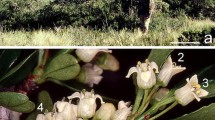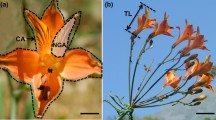Abstract
Empirical studies into obligate pollination mutualisms which elucidate the variation in reproductive performance of shrinking populations within human-altered environments are rare. This study focuses on the obligate pollination mutualism between Trollius europaeus (Ranunculaceae) and fly species of the genus Chiastocheta which act both as the plant’s main pollinators and as predators in that their larvae eat a fraction of the developing seeds. The study area is situated in the lowlands of north-east Germany. Many populations of T. europaeus have become comparatively small and scattered in this region as a consequence of agricultural land use intensification. We studied the plant’s reproductive fitness in populations ranging in size from 7 to 12,000 flowers. In a field experiment, we applied four pollination treatments and also recorded fly density in 28 natural T. europaeus populations. The fitness of the offspring from 19 populations was studied in a common garden experiment. In both approaches, a reduction in the fitness of small host plant populations could be demonstrated. Fitness loss can be put down to the quantitative and qualitative limitation of pollen caused by inbreeding and the negative feedback on relative seed set caused by the reduced ability of small plant populations to support a sufficiently large fly population. Although increases in fly density are associated with rising predation costs, the plant species’ net benefit is a positive function of its population size. Our study highlights the reproductive variability of the Trollius–Chiastocheta interaction along a population size gradient in a marginal region of its range, thus contributing to the understanding of the overall variability of this mutualism.


Similar content being viewed by others
References
Aizen MA, Harder LD (2007) Expanding the limits of the pollen-limitation concept: effects of pollen quantity and quality. Ecology 88:271–281
Anstett M-C, Michaloud G, Kjellberg F (1995) Critical population size for fig/wasp mutualism in a seasonal environment: effect and evolution of the duration of female receptivity. Oecologia 103:453–461
Anstett M-C, Hossaert-McKey M, McKey D (1997) Modeling the persistence of small populations of strongly interdependent species: figs and fig wasps. Conserv Biol 11:204–213
Antonovics J (1976) The nature of limits to natural selection. Ann Mo Bot Gard 63:224–247
Ashman T-L, Knight TM, Steets JA, Amarasekare P, Burd M, Campbell DR, Dudash MR, Johnston MO, Mazer SJ, Mitchell RJ, Morgan MT, Wilson WG (2004) Pollen limitation of plant reproduction: ecological and evolutionary causes and consequences. Ecology 85:2408–2421
Bates D (2005) Fitting linear mixed models in R. R News 5:27–30
Bronstein JL (1989) A mutualism at the edge of its range. Experientia 45:622–637
Bronstein JL (2001) The costs of mutualism. Am Zool 41:825–839
Bronstein JL, Dieckmann U, Ferrière R (2004) Coevolutionary dynamics and the conservation of mutualisms. In: Ferrière R, Dieckmann U, Couvet D (eds) Evolutionary conservation biology. Cambridge University Press, Cambridge, pp 305–326
Byers DL (1995) Pollen quantity and quality as explanations for low seed set in small populations exemplified by Eupatorium (Asteraceae). Am J Bot 82:1000–1006
Castro J (1999) Seed mass versus seedling performance in Scots pine: a maternally dependent trait. New Phytol 144:153–161
Charlesworth D, Charlesworth B (1987) Inbreeding depression and its evolutionary consequences. Annu Rev Ecol Syst 18:237–268
Colling G, Reckinger C, Matthies D (2004) Effects of pollen quantity and quality on reproduction and offspring vigor in the rare plant Scorzonera humilis (Asteraceae). Am J Bot 91:1774–1782
Crawley MJ (2007) The R Book. Wiley, Chichester
Després L, Ibanez S, Hemborg ÅM, Godelle B (2007) Geographic and within-population variation in the globeflower–globeflower fly interaction: the costs and benefits of rearing pollinators’ larvae. Oecologia 151:240–250
Dodd GL, Linhart YB (1994) Reproductive consequences of interactions between Yucca glauca (Agavaceae) and Tegeticula yuccasella (Lepidoptera) in Colorado. Am J Bot 81:815–825
Dudash MR, Fenster CB (2000) Inbreeding and outbreeding depression in fragmented populations. In: Young A, Clarke G (eds) Genetics, demography, and viability of fragmented populations. Cambridge University Press, Cambridge, pp 55–74
Dufay M, Anstett M-C (2003) Conflicts between plants and pollinators that reproduce within inflorescences: evolutionary variations on a theme. Oikos 100:3–14
Eckert CG, Samis KE, Lougheed SC (2008) Genetic variation across species’ geographical ranges: the central-marginal hypothesis and beyond. Mol Ecol 17:1170–1188
Fischer M, Matthies D (1998) Effects of population size on performance in the rare plant Gentianella germanica. J Ecol 86:195–204
Hemborg ÅM, Després L (1999) Oviposition by mutualistic seed-parasitic pollinators and its effects on annual fitness of single- and multi-flowered host plants. Oecologia 120:427–436
Herlihy CR, Eckert CG (2005) Evolution of self-fertilization at geographical range margins? A comparison of demographic, floral, and mating system variables in central vs. peripheral populations of Aquilegia canadensis (Ranunculaceae). Am J Bot 92:744–751
Hobbs RJ, Yates CJ (2003) Impacts of ecosystem fragmentation on plant populations: generalising the idiosyncratic. Aust J Bot 51:471–488
Holland JN, DeAngelis DL (2001) Population dynamics and the ecological stability of obligate pollination mutualisms. Oecologia 126:575–586
Holland JN, Fleming TH (1999) Geographic and population variation in pollinating seed-consuming interactions between senita cacti (Lophocereus schottii) and senita moths (Upiga virescens). Oecologia 121:405–410
Holland JN, DeAngelis DL, Bronstein JL (2002) Population dynamics and mutualism: functional response of benefits and costs. Am Nat 159:231–244
Hossaert-McKey M, Bronstein JL (2001) Self-pollination and its costs in a monoecious fig (Ficus aurea, Moraceae) in a highly seasonal subtropical environment. Am J Bot 88:685–692
Hultén E, Fries M (1986) Atlas of North European vascular plants. Koeltz, Königstein
Husband BC, Schemske DW (1996) Evolution of the magnitude and timing of inbreeding depression in plants. Evolution 50:54–70
Jacquemyn H, Brys R, Hermy M (2001) Within and between plant variation in seed number, seed mass and germinability of Primula elatior: effect of population size. Plant Biol 3:561–568
Jaeger N, Després L (1998) Obligate mutualism between Trollius europaeus and its seed-parasite pollinators Chiastocheta flies in the Alps. CR Acad Sci III 321:789–796
Johannesen J, Loeschcke V (1996) Distribution, abundance and oviposition patterns of four coexisting Chiastocheta species (Diptera: Anthomyiidae). J Anim Ecol 65:567–576
Kalisz S, Vogler DW (2003) Benefits of autonomous selfing under unpredictable pollinator environments. Ecology 84:2928–2942
Klank C, Pluess AR, Ghazoul J (2010) Effects of population size on plant reproduction and pollinator abundance in a specialized pollination system. J Ecol 98:1389–1397
Klank C, Ghazoul J, Pluess AR (2012) Genetic variation and plant performance in fragmented populations of globeflowers (Trollius europaeus) within agricultural landscapes. Conserv Genet 13:873–884
Knight TM, Steets JA, Vamosi JC, Mazer SJ, Burd M, Campbell DR, Dudash MR, Johnston MO, Mitchell RJ, Ashman T-L (2005) Pollen limitation of plant reproduction: pattern and process. Annu Rev Ecol Evol Syst 36:467–497
Lawton JH (1993) Range, population abundance and conservation. Trends Ecol Evol 8:409–413
Lehtilä K, Ehrlén J (2005) Seed size as an indicator of seed quality: a case study of Primula veris. Acta Oecol 28:207–212
Leimu R, Mutikainen P, Koricheva J, Fischer M (2006) How general are positive relationships between plant population size, fitness and genetic variation? J Ecol 94:942–952
Leishman MR (2001) Does the seed size/number trade-off model determine plant community structure? An assessment of the model mechanisms and their generality. Oikos 93:294–302
Menges ES (1991) The application of minimum viable population theory to plants. In: Falk DA, Holsinger KE (eds) Genetics and conservation of rare plants. Oxford University Press, Oxford, pp 47–61
Oostermeijer JGB, Altenburg RGM, den Nijs HCM (1995) Effects of outcrossing distance and selfing on fitness components in the rare Gentiana pneumonanthe (Gentianaceae). Acta Bot Neerl 44:257–268
Pellmyr O (1989) The cost of mutualism: interactions between Trollius europaeus and its pollinating parasites. Oecologia 78:53–59
Pellmyr O (1992) The phylogeny of a mutualism: evolution and co-adaptation between Trollius and its seed-parasitic pollinators. Biol J Linn Soc 47:337–365
Pellmyr O, Massey LK, Hemrick JL, Feist MA (1997) Genetic consequences of specialization: yucca moth behavior and self-pollination in yuccas. Oecologia 109:273–278
Poschlod P, Bakker JP, Kahmen S (2005) Changing land use and its impact on biodiversity. Basic Appl Ecol 6:93–98
R Development Core Team (2009) R: a language and environment for statistical computing. R Foundation for Statistical Computing, Vienna
Ramsey M, Vaughton G (2000) Pollen quality limits seed set in Burchardia umbellata (Colchicaceae). Am J Bot 87:845–852
Sih A, Baltus M-S (1987) Patch size, pollinator behavior, and pollinator limitation in catnip. Ecology 68:1679–1690
Sletvold N (2002) Effects of plant size on reproductive output and offspring performance in the facultative biennial Digitalis purpurea. J Ecol 90:958–966
Thompson JN (1988) Variation in interspecific interactions. Annu Rev Ecol Syst 19:65–87
Turnbull LA, Rees M, Crawley MJ (1999) Seed mass and the competition/colonization trade-off: a sowing experiment. J Ecol 87:899–912
Venable DL (1992) Size-number trade-offs and the variation of seed size with plant resource status. Am Nat 140:287–304
Waser NM, Price MV (1994) Crossing-distance effects in Delphinium nelsonii: outcrossing and inbreeding depression in progeny fitness. Evolution 48:842–852
Wilcove DS, McLellan CH, Dobson AP (1986) Habitat fragmentation in the temperate zone. In: Soule M (ed) Conservation Biology. Sinauer, Sunderland, pp 237–256
Willi Y, van Buskirk J, Fischer M (2005) A threefold genetic Allee effect: population size affects cross-compatibility, inbreeding depression and drift load in the self-incompatible Ranunculus reptans. Genetics 169:2255–2265
Acknowledgments
We would like to thank K. Nickschick, F. Möbius and D. Riebold for field assistance, K. Fink, H. Padberg and the staff of the University of Rostock Botanic Garden for assistance with the common garden experiment, and S. Adler for help with statistical analysis. We are also grateful to I. Duty and A. Grossmann for useful advice on identifying Chiastocheta species. Laurence Després, E. Elle and two anonymous reviewers are acknowledged for valuable comments on earlier drafts of the manuscript and L. Cathrow for linguistic improvement. The authors declare that they have no conflict of interest and that experiments comply with the current laws of our country (Germany).
Author information
Authors and Affiliations
Corresponding author
Additional information
Communicated by Elizabeth Elle.
Electronic supplementary material
Below is the link to the electronic supplementary material.
Rights and permissions
About this article
Cite this article
Lemke, T., Porembski, S. Variation in the reproductive performance of the Trollius–Chiastocheta mutualism at the edge of its range in north-east Germany. Oecologia 172, 437–447 (2013). https://doi.org/10.1007/s00442-012-2500-z
Received:
Accepted:
Published:
Issue Date:
DOI: https://doi.org/10.1007/s00442-012-2500-z




